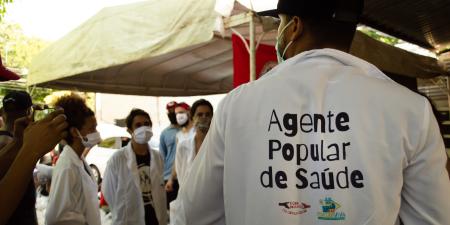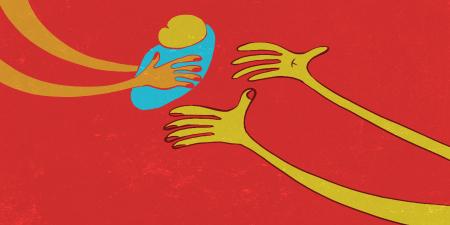Abstract
Devastating effects of COVID-19 among Latinos have not been adequately emphasized or addressed by media, public health experts, researchers, or government officials. Moreover, the underreporting of the crisis’ effect on Latinos and the undercounting of cases continues even as programs, initiatives, and policies are designed and implemented to mitigate the spread of the virus; to allocate resources to lessen the economic, educational, housing, and nutritional consequences of COVID; and to direct recovery planning. The invisibility and systematic neglect of the Latino population has contributed to Latino individuals’ disproportionately high rates of infection, hospitalization, and death. Changing the COVID-19 narrative is necessary in order to ensure appropriate and equitable responses to the pandemic’s effect on Latinos.
Case
With COVID-19 cases declining in the second quarter of 2021, media attention turned to growing concern over the new COVID patient: White, young, healthy—and hospitalized.1,2 These headlines erased the reality of the devastating effects of COVID-19 on the Latino community, contradicting what health care workers, family members, and community members have been experiencing since April 2020. Because the Latino population is so much younger than the total population (ie, up to 59% of Latinos vs 46% in the total population are under the age of 35), COVID cases and death from COVID among the young was nothing “new” in the Latino population.3
Commentary
By May 2021, COVID-19 had infected over 33 million people in the United States, resulting in nearly 600 000 deaths.3,4,5 While it is often said that “COVID does not discriminate,” the data paint a very different picture. As an example of what is occurring across the country, as of May 31, 2021, about 11% of Illinois’ Latino population had been diagnosed with COVID-19 compared to approximately 7% of Illinois’ White population.6,7 Consistent with Latino invisibility, largely ignored is the story that COVID has disproportionately sickened, hospitalized, and killed younger Latinos—essential workers who, because of economic necessity, become sick and die.8 Age-adjusted mortality rates expose a largely unrecognized burden: Latinos die at a 2.3 times higher rate than White Americans.9
Latinos are also at increased risk for contracting COVID-19.5 Risk factors include occupational exposure to the virus3; residing in multigenerational, overcrowded living spaces10; and employment status.3 Indeed, these factors are better predictors of Latino COVID cases and deaths than underlying health conditions (except heart disease).3 Moreover, Latinos had the lowest rates of health insurance coverage among all racial or ethnic groups except American Indians/Alaska Natives in 2019.11 These findings are consistent with socioeconomic status being a significant risk for contracting COVID-19.12 For the Latino community, long-standing endemic inequity and discrimination have resulted in unacceptably high rates of poverty, educational disadvantage, neighborhood segregation, language discordance, and uncertain citizenship status.10 The COVID-19 pandemic has exacerbated Latinos’ economic distress.8
Latinos Made Invisible
In April 2021, a surge of cases and deaths in young, healthy adults in Michigan13 and a focus on the long-term effects of COVID in children14 drew the attention of the American public. While these topics deserve attention, in late spring of 2020, another topic had been raised: Latino invisibility. In April 2020, while speaking at a Unidos community forum in Chicago, Aida Giachello, a Latina leader familiar with the devastating impact that COVID-19 was having on younger Latinos, noted that current narratives circulating in the media and in the medical community, as well as statements by public health and other government officials, were incomplete. She went on to note that stories and reports of COVID’s effects on Latinos in the context of other communities of color highlighted commonalities but ignored significant differences. And it is those differences (eg, language barriers, documentation status, low level of government relief funds, and multigenerational, overcrowded housing) that largely underlay the disproportionate impact that COVID was having on the Latino community. This observation led her to conclude: “it’s as if members of our community are invisible or, even worse, expendable.”
One example of Latino invisibility is the phased early vaccine rollout. One goal of vaccine distribution guidelines proposed by the Advisory Committee on Immunization Practices of the Centers for Disease Control and Prevention was reduction of COVID-19’s disproportionate burdens.15 A phased rollout prioritizing health care workers and older adults, however, resulted in a disconcerting trend. Instead of creating equity, the early vaccine rollout created a disconnect between people’s risk of contracting COVID-19 and their access to the vaccine. Latinos were unable to secure early access to vaccines because, while they were overwhelming employed as essential workers, they were not in occupational sectors that were the highest priority for early access to the vaccine.16,17 This meant that they continued to get sick and die due to COVID-19. These essential workers (eg, custodial workers, grocery store workers, delivery personnel), often touted as “heroes,” were, at best, invisible and, in some cases, indeed expendable.
Instead of creating equity, the early vaccine rollout created a disconnect between risk of contracting COVID-19 and access to the vaccine.
Another example of the invisible Latino COVID patient is when municipalities and states began to relax mask-wearing and physical distancing requirements. As the pandemic expanded among young White Americans, levels of COVID exposure among Latino workers in the hospitality industry intensified. In early 2021, behavioral choices produced a startling acceleration in COVID infection numbers among young White Americans taking full advantage of relaxed rules by going to bars and restaurants, as exemplified by one Illinois bar whose February 2021 opening event was linked to 46 COVID-19 cases.18 As the mainstream media raised the alarm about these new COVID patients, largely ignored were the increasing rates of COVID infection among young Latinos—the workers in those bars and restaurants who were getting sick and dying.
At the same time that news headlines emerged about deaths of young and White COVID patients, an article appeared in Vox on the psychological problems affecting children who lost parents to COVID.19 The article called attention to the moral imperative to focus on these children and their need for attention and resources, most notably psychological care. As of November 11, 2021, in Illinois, Latinos accounted for about 35% of deaths among those aged 20 to 59.6 These data underscore the burden of parental loss that Latino children are bearing. And yet the study of children who had lost at least one parent to COVID on which the Vox article was based noted only the deaths of parents of non-Hispanic White children and non-Hispanic Black children because it did not include ethnicity as a variable.14 The Vox article therefore fails to mention the moral imperative to examine the needs of Latino children.19 Once again, we are led to the uncomfortable conclusion that Latinos—and, in this case, also their children—are invisible in the dominant narratives.
Policy Implications
Lord Kelvin noted that if you cannot measure something, you cannot improve it.20 The invisibility of Latinos leads to misreporting of the true impact of COVID on Latinos, thereby minimizing the presence and consequences of COVID within the Latino community. Latinos’ invisibility is likely a significant contributing factor to their disproportionately high rates of cases, hospitalization, and death. Programs, initiatives, and mitigation strategies cannot be targeted to Latinos when relevant measurements fail to be taken. For example, because testing was inadequate in Latino communities across the country, an accurate representation of COVID’s spread among Latinos was absent in the spring and summer of 2020.21 Equitable distribution of resources becomes an elusive goal because the depth of the problem is not reported,22 and accurate data is difficult to come by as there is no centralized, systematic set of race/ethnicity definitions and reporting requirements. Hospitals, health systems, and local public health entities use different methodologies for collection of data on race/ethnicity.23 This methodological variation leads to the unfortunate consequence of inaccurate reporting of the incidence and prevalence of COVID among Latinos. The continuation of poor data collection perpetuates Latinos’ invisibility, thereby ensuring that Latinos remain at a disproportionately high risk for infection, illness, and death.
Because immigration status has been used as a criterion for eligibility for government assistance, health care assistance programs as well as economic recovery polices implemented in response to the COVID-19 pandemic have been inaccessible to many Latinos and their families. This inaccessibility has no economic justification. For example, considering the tens of billions of dollars in federal, state, and local taxes annually paid by undocumented immigrants,24 there is no economic justification for immigration status to be a criterion in policy and resource allocation decisions. With approximately 8 million Latinos in the United States—or about 13% of the total Latino population—being undocumented,25 immigration status has rendered many individuals and families ineligible26 for federal relief and stimulus dollars, housing assistance, and insurance subsidies through the Affordable Care Act.22,27
To ensure that Latinos are rendered visible and that their risk for infection, hospitalization, and death is reduced, we recommend the following actions: enhancing data collection by prioritizing collecting both ethnic and racial data; viewing resource allocation questions through an equity lens to ensure that the distribution of resources reflects the presence and impact of COVID; and eliminating immigration status as an eligibility requirement for publicly funded health, housing, and nutritional programs, as well as COVID-related relief payment and programs.
Making Latinos Visible
Unnamed problems produce inequitable solutions, and nowhere is this better illustrated than in the case of Latinos and COVID. The frequent invisibility of Latinos in the COVID narrative—and therefore in policy and resource allocation decisions—underscores the necessity of a call to action. Actions must center on developing a narrative that is inclusive and accurately reflective of the crisis and on developing both data collection methods that capture the realities of COVID’s impact on all communities and a set of metrics to gauge if the actions and narratives align to ensure equitable distributive policies. Failing to take up this call to action means that inattention and inequity will continue to define the response to COVID in the Latino community.
References
-
Marquez M. In Michigan’s latest coronavirus surge, there’s a new kind of patient. CNN. April 5, 2021. Accessed December 2, 2021. https://www.cnn.com/2021/04/05/us/michigan-covid-surge-patients-variants/index.html
-
Puente S, Del Rios M. COVID’s invisible victims. Chicago Reader. May 7, 2021. Accessed February 17, 2022. https://chicagoreader.com/news-politics/covids-invisible-victims/
-
Rodriguez-Diaz CE, Guilamo-Ramos V, Mena L, et al. Risk for COVID-19 infection and death among Latinos in the United States: examining heterogeneity in transmission dynamics. Ann Epidemiol. 2020;52:46-53.e2
- Martínez ME, Nodora JN, Carvajal-Carmona LG. The dual pandemic of COVID-19 and systemic inequities in US Latino communities. Cancer. 2021;127(10):1548-1550.
-
Do DP, Frank R. Using race-and age-specific COVID-19 case data to investigate the determinants of the excess COVID-19 mortality burden among Hispanic Americans. Demogr Res. 2021;44:699-718.
-
COVID-19 statistics. Illinois Department of Public Health. Accessed December 2, 2021. https://dph.illinois.gov/covid19/data.html
-
QuickFacts: Illinois. US Census Bureau. Accessed May 31, 2021. https://www.census.gov/quickfacts/IL
-
Gamboa S. “Hellish”: Covid deaths have struck younger Latinos. Here’s the economic, social fallout. NBC News. December 28, 2020. Accessed February 17, 2022. https://www.nbcnews.com/news/latino/hellish-covid-deaths-have-struck-younger-latinos-here-s-economic-n1251613
-
Risk for COVID-19 infection, hospitalization, and death by race/ethnicity. Centers for Disease Control and Prevention. Updated September 9, 2021. Accessed November 4, 2021. https://www.cdc.gov/coronavirus/2019-ncov/covid-data/investigations-discovery/hospitalization-death-by-race-ethnicity.html
-
Profile: Hispanic/Latino Americans. Office of Minority Health, US Department of Health and Human Services. Accessed December 2, 2021. https://minorityhealth.hhs.gov/omh/browse.aspx?lvl=3&lvlid=64
-
Artiga S, Tolbert J, Orgera K. Hispanic people are facing widening gaps in health coverage. Kaiser Family Foundation. November 6, 2020. Accessed December 2, 2021. https://www.kff.org/policy-watch/hispanic-people-facing-widening-gaps-health-coverage/
-
Artiga S, Garfield R, Orgera K. Communities of color at higher risk for health and economic challenges due to COVID-19. Kaiser Family Foundation. April 7, 2020. Accessed December 2, 2021. https://www.kff.org/coronavirus-covid-19/issue-brief/communities-of-color-at-higher-risk-for-health-and-economic-challenges-due-to-covid-19/
-
Smith M, Mervosh S. Michigan’s COVID wards are filling up with younger patients. New York Times. April 25, 2021. Accessed February 17, 2022. https://www.nytimes.com/2021/04/25/us/michigan-covid-younger-people-hospitalized.html
- Kidman R, Margolis R, Smith-Greenaway E, Verdery AM. Estimates and projections of COVID-19 and parental death in the US. JAMA Pediatr. 2021;175(7):745-746.
- Dooling K, Marin M, Wallace M, et al. The Advisory Committee on Immunization Practices’ updated interim recommendation for allocation of COVID-19 vaccine—United States, December 2020. MMWR Morb Mortal Wkly Rep. 2021;69(5152):1657-1660.
- Painter EM, Ussery EN, Patel A, et al. Demographic characteristics of persons vaccinated during the first month of the COVID-19 vaccination program—United States, December 14, 2020-January 14, 2021. MMWR Morb Mortal Wkly Rep. 2021;70(5):174-177.
-
Dubay L, Aarons J, Brown S, Kenney GM. How risk of exposure to the coronavirus at work varies by race and ethnicity and how to protect the health and well-being of workers and their families. Urban Institute; 2020. Accessed December 2, 2021. https://www.urban.org/sites/default/files/publication/103278/how-risk-of-exposure-to-the-coronavirus-at-work-varies_1.pdf
- Sami S, Turbyfill CR, Daniel-Wayman S, et al. Community transmission of SARS-CoV-2 associated with a local bar opening event—Illinois, February 2021. MMWR Morb Mortal Wkly Rep. 2021;70(14):528-532.
-
Resnick B. The shadow orphan crisis of Covid-19. Vox. April 20, 2021. Accessed February 17, 2022. https://www.vox.com/science-and-health/22386227/covid-19-child-bereavement-orphans
- Merton RK, Sills DL, Stigler SM. The Kelvin dictum and social science: an excursion into the history of an idea. J Hist Behav Sci. 1984;20(4):319-331.
-
Fraser J, Mansfield E, Wynn M, Linesburgh S. Leaders were slow to bring COVID-19 testing to Latino communities. Now people are sick. USA Today. July 29, 2020. Accessed February 17, 2022. https://www.usatoday.com/story/news/2020/07/29/covid-testing-latinos-cases-inadequate-outreach-data/5443140002/
-
Kristian R. Latinos hit hard by coronavirus, but Chicago suggests it’s even worse than it looks. Washington Post. July 10, 2020. Accessed December 2, 2021. https://www.washingtonpost.com/health/latinos-hit-hard-by-coronavirus-but-chicago-suggests-its-even-worse-than-it-looks/2020/07/10/a4ae1b62-bfa6-11ea-b4f6-cb39cd8940fb_story.html
- Gross CP, Essien UR, Pasha S, Gross JR, Wang SY, Nunez-Smith M. Racial and ethnic disparities in population-level Covid-19 mortality. J Gen Intern Med. 2020;35(10):3097-3099.
-
Shoichet CE. Undocumented immigrants are paying their taxes today, too. CNN. April 15, 2019. Accessed February 17, 2022. https://www.cnn.com/2019/04/15/us/taxes-undocumented-immigrants/index.html
-
Gamboa S. Americans way off on number of Latinos they think are undocumented, poll finds. NBC News. September 30, 2021. Accessed February 17, 2022. https://www.nbcnews.com/news/latino/americans-way-number-latinos-think-are-undocumented-poll-finds-rcna2464
-
Immigrant eligibility for public programs during COVID-19. Protecting Immigrant Families. Updated March 26, 2021. Accessed December 2, 2021. https://protectingimmigrantfamilies.org/immigrant-eligibility-for-public-programs-during-covid-19/
-
Immigration status and the marketplace. HealthCare.gov. Accessed December 2, 2021. https://www.healthcare.gov/immigrants/immigration-status/



